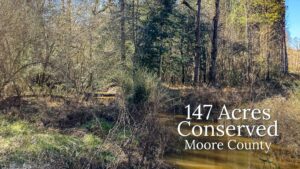
by Ruth Ann Grissom
August 19, 2015
There’s a difference between spending time in the woods and understanding the complex dynamics of a forest. For far too many people, even outdoor enthusiasts, nuances such as species diversity and forest succession are lost in a blur of green. That doesn’t bode well for a fast-growing state where nearly 85% of our forests are privately owned. As forests are fragmented or lost to development, it becomes increasingly important for us to be informed so we can make good management decisions on behalf of our working forests and natural areas.
Fortunately, North Carolina has a program for teachers who want to prepare their students to be good stewards of our forests. During their summer vacation, 31 intrepid educators braved the heat, humidity, ticks and chiggers to learn about forestry issues in the Piedmont. They came from across the state, from rural and urban areas, from grades K-12, and from public and private schools to attend a 3-day workshop organized by the Cooperative Extension Service at NC State and the NC Forestry Association.
The NC Sustainable Forestry Teachers’ Academy has been held at sites near Asheville and New Bern for more than a decade, but for its inaugural year in the Piedmont, organizers chose to showcase our region’s forests and forestry products in the Uwharries. Within a 20-mile radius of Montgomery Community College, the group could visit the Uwharrie National Forest, Morrow Mountain State Park, private timber tracts, Troy Lumber, Uwharrie Lumber, Jordan Lumber and Lancer Furniture.
The curriculum is impressive in its breadth and depth, beginning with an overview of the forest types in our state, from the white pine forest found in pockets of the Appalachians to the oak-hickory forest that covers much of the Piedmont to the remaining patches of longleaf in the Sandhills and Coastal Plain. Another section delves into the natural history of the Southern forest, including the important role of fire. A timeline highlights forestry milestones, noting that the state’s first paper mill was built near Hillsborough in 1777, our first furniture factory opened in High Point in 1888, and our first national forest was established in 1916.
The section on wood products begins with an exhaustive list which goes well beyond the obvious – i.e. paper, furniture and building materials – and includes such whimsical items as toilet seats, wine racks, musical instruments, rolling pins, crucifixes and checker sets. Teachers are challenged to think deeper about topics ranging from paper recycling to carbon sequestration and the use of biomass as an energy source.
The forest management section is geared toward production on private lands, with an emphasis on selling timber and working with a consulting forester. An article previously published in Wildlife in North Carolina makes a compelling case for clear cuts, while other materials address the benefits of using prescribed fire, fighting invasive species and diversifying timber tracts with longleaf and shortleaf. These issues dovetail with the section devoted to wildlife and ecology. There’s a list of priority species associated with the forests of the Piedmont – birds, mammals, reptiles and amphibians – as well as information about managing for game species such turkey, deer and bobwhite quail. Another article touts the presence of dead trees, snags and downed logs in a healthy forest.
The curriculum recognizes the precarious nature of forests in a rapidly urbanizing state. A truly concerning map suggests that almost every unprotected woodlot in the Piedmont is at risk of being lost to development. While cities might not have extensive working forests or natural areas, they still need trees to create appealing business districts, improve air quality, reduce energy costs and provide backyard habitats. Finally, the curriculum encourages students to consider a career in forestry or natural resource conservation, a path that might be less obvious for kids in Charlotte than in the Uwharries.
Teachers are also provided with lesson plans so they have innovative ways to share this knowledge with their students. With a mounting body of evidence that suggests spending time outdoors in nature helps kids pay attention in the classroom, the forest itself ought to be an integral part of the school day. When I think back to the fun we had building a nature trail on the West Montgomery campus during Mrs. Koch’s advanced biology class, I envy the students who will find themselves in a classroom this fall with one of the dedicated graduates of the NC Sustainable Forestry Teachers’ Academy.
For more information, contact Renee Strnad (renee_strnad@ncsu.edu) or visit Project Learning Tree (http://forestry.ces.ncsu.edu/ncplt/).